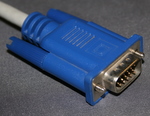DIY hand-held games console: Faster GUI
Last updated: 19 Apr 2023 - 22:19
It's been a while since I got anything done on the Noodle Game console, but I found it on my desk and had a few minutes to spare so thought I'd have a crack at upgrading the screen driver code. It was a little bit of a disappointing exercise but at least I've learned some things.
Stuck in 24 bit
The screen supposedly supports a bunch of different colour depths including 18 bit (6 bits of each colour) note that this isn't a nice multiple of 8, a 16 bit mode where green has 6 bits but red and blue only 5 and apparently even a 3 bit mode where it has just one bit per colour like a Sinclair Spectrum. Unfortunately in SPI mode it only supports either the 8 bit or the full 18 bit modes. In 18 bit mode the colours are padded to a full byte each and so need three bytes per pixel.
Slow clock
The screen module I've got is hard-wired to SPI mode. The module can do parallel RGB, host bus or even MIPI-DSI apparently all of which offer faster data transfers and a choice of colo
DIY hand-held games console: Screen Driver
Last updated: 13 Jul 2022 - 22:40
Now that the toolchain and the basics are working, the next thing to do is to start getting some of the peripherals working. I like to do this one at a time and it's usually best to start with the outputs first, that way you can use the outputs to test whether the inputs are working. We've proven the basic UART comms already, so the next big output device is the screen. The screen I've got came from eBay but appears to match up with this entry on LCD Wiki.
Midas Graphic OLED
Last updated: 11 Nov 2020 - 11:31
I recently included a Midas Graphic OLED 128x32 pixel display in a product I'm developing at work. The OLED is available from Farnell for a very reasonable £7.61. It's got a 0.1" pitch header for comms and 4 M2 mounting holes which makes it ideal for DIY/prototype products that don't have custom enclosures to mount a bare LCD glass panel nicely.
The big problem is the documentation which is worse than non-existent. It's confusing, misleading and in places just plain wrong. The datasheet seems to have been assembled by someone copying and pasting bits from the controller datasheet with no understanding of what the product does.
I eventually figured it out and got it working, so here are my notes.
Graphical LCD Breakout Board
Last updated: 28 Apr 2012 - 18:35
I've got an on-going project to build a battery powered device. I want to be able to run the whole thing at 3.3V so I can easily and efficiently run it off a single LiPo cell. I also want to use a simple monochrome, graphical LCD for this project, but I couldn't find one that would run off 3.3V. For various other reasons, the project requires that the LCD is a classic 8bit parallel module as I had run out of hardware serial ports and bit-banged was making the refresh seem really slow. I found a few that would run the control lines off 3.3V but still needed some higher voltage to power the screen or back-light. Eventually I bit the bullet and decided to go with one of these from Farnell because it was the cheapest back-lit 128 by 64 pixel display I could get from them. It is a really good choice as it even includes electronic contrast control, something I was expecting to have to do in external circuitry. However, it isn't a nice 0.1" pitch module, it comes out to a 0.5mm pitch FPC connection.
Pong on a VGA monitor with the ChipKIT Uno32
Last updated: 15 Jul 2011 - 19:59
Following on from my review of the new ChipKIT Uno32 from Farnell, I've done a little project to test out what it's capable of. I had never programmed for an Arduino before and I've learned a lot about the way the system works from this project. One of the early revelations which amazed me was that the Arduino "Wiring" language is in fact not a language at all but simply a couple of header files that wrap up some boiler plate C++ code. I can see the reason that it was marketed as an "easy to use language" and the mention of C++ was avoided initially as it made the platform more attractive to artists and hobbyists not interested in learning a big scary "real" programming language. The fact that you can just use any old PIC (or on the original AVR) compatibile C code makes it a lot more attractive for those wanting to dig a bit deeper.
VGA Primer
Last updated: 13 Jul 2011 - 21:51

Video Graphics Array "VGA" is a standard for computer display. It has a lot going for it in the hobby electronics field as it is a pretty simple standard and quite straight forward to implement with sufficient signalling speed, there are also a lot of monitors around to test projects on! Colour is a lot easier to generate on a VGA monitor than on a composite video monitor, but it requires a lot more speed as the frames are more detailed and there are more signals to generate.
